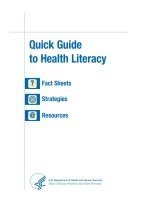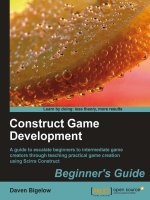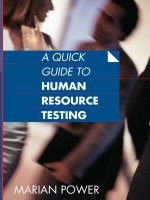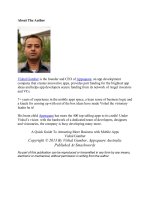Schaum's Quick Guide to Essay Writing
Bạn đang xem bản rút gọn của tài liệu. Xem và tải ngay bản đầy đủ của tài liệu tại đây (33.6 MB, 119 trang )
CĐ
WRITING
GREAT ESSAYS
etm
write and
fo write iï†
heow
° Techniques for school,
business, and special
projects
° Full coeverage of tone,
style, and substance
Schaum's Quick Guide
to Writing Great Essays
Other Books in Schaum’s Quick Guide Series
Forthcoming titles:
ScHaum’s Quick GUIDE TO WRITING GREAT SHORT STORIES
Scuaum’s Quick GUIDE TO GREAT PRESENTATION SKILLS
ScHaum’s Quick GuIDE To GREAT Business WRITING
ScHaum’s Quick GUIDE TO GREAT RESEARCH PaPERS
schaum’s Quick Guide
to Writing Great Essays
Molly McClain
Jacqueline D. Roth
McGraw-Hill
New York
San Francisco
Washington, D.C.
Auckland
Bogota
Caracas
Lisbon
London
Madrid
Mexico City
Milan
Montreal
New Delhi
San Juan
Singapore
Sydney
Tokyo
Toronto
McGraw-Hill
x2
A Division of The McGraw-Hill Companies
Copyright © 1999 by The McGraw-Hill Companies, Inc.. All rights reserved. Manufactured in the United
States of America. Except as permitted under the United States Copyright Act of 1976, no part of this publication may be reproduced or distributed in any form or by any means, or stored in a database or retrieval
system, without the prior written permission of the publisher.
0-07-136848-5
The material in this eBook also appears in the print version of this title: 0-07-047170-3.
All trademarks are trademarks of their respective owners. Rather than put a trademark symbol after
every occurrence of a trademarked name, we use names in an editorial fashion only, and to the benefit
of the trademark owner, with no intention of infringement of the trademark. Where such designations
appear in this book, they have been printed with initial caps.
McGraw-Hill eBooks are available at special quantity discounts to use as premiums and sales promotions, or for use in corporate training programs. For more information, please contact George Hoare,
Special Sales, at or (212) 904-4069.
TERMS
OF USE
This is a copyrighted work and The McGraw-Hill Companies, Inc. (“McGraw-Hill”) and its licensors
reserve all rights in and to the work. Use of this work is subject to these terms. Except as permitted
under the Copyright Act of 1976 and the right to store and retrieve one copy of the work, you may not
decompile,
disassemble,
reverse engineer,
reproduce,
modify,
create derivative
works
based
upon,
transmit, distribute, disseminate, sell, publish or sublicense the work or any part of it without McGrawHill’s prior consent. You may use the work for your own noncommercial and personal use; any other
use of the work is strictly prohibited. Your right to use the work may be terminated if you fail to comply with these terms.
THE WORK IS PROVIDED “AS IS”. McGRAW-HILL AND ITS LICENSORS MAKE NO GUARANTEES OR WARRANTIES AS TO THE ACCURACY, ADEQUACY OR COMPLETENESS OF
OR RESULTS TO BE OBTAINED FROM USING THE WORK, INCLUDING ANY INFORMATION THAT CAN BE ACCESSED THROUGH THE WORK VIA HYPERLINK OR OTHERWISE,
AND EXPRESSLY DISCLAIM ANY WARRANTY, EXPRESS OR IMPLIED, INCLUDING BUT
NOT LIMITED TO IMPLIED WARRANTIES OF MERCHANTABILITY OR FITNESS FOR A PARTICULAR
PURPOSE.
McGraw-Hill and its licensors do not warrant or guarantee that the functions
contained in the work will meet your requirements or that its operation will be uninterrupted or error
free. Neither McGraw-Hill nor its licensors shall be liable to you or anyone else for any inaccuracy,
error or omission, regardless of cause, in the work or for any damages resulting therefrom. McGrawHill has no responsibility for the content of any information accessed through the work. Under no circumstances shall McGraw-Hill and/or its licensors be liable for any indirect, incidental, special, punitive, consequential or similar damages that result from the use of or inability to use the work, even if
any of them has been advised of the possibility of such damages. This limitation of liability shall apply
to any claim or cause whatsoever whether such claim or cause arises in contract, tort or otherwise.
DOI: 10.1036/007 1368485
Contents
Preface
Vil
PART | MAKE AN ARGUMENT
Chapter 1—How
You
to Identify a Topic That Interests
Chapter 2—How to Identify a Topic Question
15
Chapter 3— How to Write a Thesis Statement
25
PART Il PROVE YOUR ARGUMENT
31
Chapter 4—How
33
to Use Evidence
Chapter 5—How to Use Reasoning
45
Chapter 6—How to Structure an Argument
53
PART IIIPLAN YOUR
WRITING
Chapter 7—How
65
STRATEGY
to Plan Your Writing Strategy
67
Chapter 8—How to Improve Your Writing Style
81
Chapter 9—How to Evaluate Your Writing
93
Vv
Copyright 1999 The McGraw-Hill Companies, Inc.
Click Here for Terms of Use
Appendix A—Research Tips
vi
97
Bibliography
103
Index
105
Preface
Schaum’s Quick Guide to Writing Great Essays is concerned with
only one type of writing: the essay. If you are in college, knowing
how to write an essay is a practical matter of survival, for it is the
basis of essay exams as well as student research papers. Even the
most simple assignments—those asking you to summarize and
comment on a text—depend on your ability to understand the struc-
ture of an author’s argument.
Once
you
are out of college, you will find that the essay is
the basis of nonfiction books, newspaper and magazine articles,
speeches, legal briefs and opinions, and persuasive business communications. Regardless of what profession you choose to enter, you
are going to be called on to use the principles
writing the essay to present your ideas to others.
you learned
in
If you need detailed help in other areas of writing, such as
writing as an expressive art form, there are some excellent books
available at your local bookstore.
Moiry MecCLAIN
JACQUELINE D. Rotu
vii
Copyright 1999 The McGraw-Hill Companies, Inc.
Click Here for Terms of Use
This page intentionally left blank.
schaum’s Quick Guide
to Writing Great Essays
This page intentionally left blank.
Part |
MAKE AN ARGUMENT
An essay is assigned to enable a student to learn three things:
1.
How to explore a subject area and to make a judgment about a particular issue.
2.
How to create an argument supporting that judgment
using reasoning and evidence.
3.
How to write an interesting and coherently organized
essay.
The purpose of writing an essay is to persuade an educated,
and critical, reader that your point of view on a topic is correct. You
cannot do this by indulging in emotional pleas or by listing fact
after innumerable
fact. Instead, you must
make
a well-reasoned
and coherent argument that is backed by authoritative evidence.
The following chapters will teach you how to do this.
The first section of this book focuses on the development of a
thesis statement, a declarative sentence that tells your reader what
you think about a topic. In other words, it is your opinion. It is also
a response to what we have called the topic question.
If you are in school, your teachers often will present you with
a topic question in the form of an “essay question.” Your job is to
answer that query and to organize an argument using the available
sources. In this case, you may turn directly to Chapter 3, “How to
Write a Thesis Statement.” However, if you are writing a research
paper in which you have to determine your own topic question, read
Chapters 1 and 2.
Chapter 1 shows you how to explore a subject area and to find
a topic that interests you. This is the first step in writing a research
1
Copyright 1999 The McGraw-Hill Companies, Inc.
Click Here for Terms of Use
paper, and it is not as easy as it seems. You need to break down a
large subject area into a smaller number of topics, which can be
explored in the time and space available. You also need to ask ques-
tions—lots of questions—about your topic. This will help you to
focus your thinking and to find an important question to write
about.
Chapter 2 shows you how to identify the topic question that
will direct your research and lead directly to your thesis statement.
This is the most important, and often the most neglected, feature of
essay writing. If you do not have a topic question, you will not be
able to formulate a thesis statement.
Chapter 3 shows you how to turn your topic question into a
clear and forceful thesis statement. It also provides you with ways
to evaluate your thesis. Have you stated it fairly? Can you prove it
in the time and space available?
Chapter 1
How to Identify a Topic
That Interests You
How do you find a topic—a good topic—for your essay? You start by
defining the larger subject about which you are required to write.
For example, if you are taking a class on the history of China, you
may choose to write an essay on the subject of “China in
Revolution.” Of course, you cannot describe the whole history of
Communist
China in a ten-page research paper. Instead, you have
to break this general subject down into smaller, more manageable
topics. Once you select several possible topics, you use the reasoning process called inquiry to explore those topics further.
This chapter shows you how to find a topic that can be
explored in the amount of time available and with the research
materials on hand. It also lists some questions that you need to ask
at this stage of the research process. It is crucial for you to ask
many questions about the topics you are exploring. Questions help
you to refine your thinking and to formulate a good topic question;
they also shape the direction of your research.
Finally, we encourage you to ask so what? Why
do you think
that your topic is important and relevant? How can you draw on
your own special interests, experiences, and abilities to write an
interesting
and
intellectually
stimulating
essay?
If you
take the
trouble to find a topic about which you care deeply, you are likely to
write a very good essay. If you are bored by your topic—trust us—
your readers will be too.
3
Copyright 1999 The McGraw-Hill Companies, Inc.
Click Here for Terms of Use
What Are Subjects and Topics?
A.
WHAT IS A SUBJECT?
1.
2.
A-subject is the area of knowledge where you will search
for a topic and a topic question. Think of the subject as
a large box filled with smaller boxes of the same size
and shape.
The name of your college class can serve as your subject.
EXAMPLES:
History of China (History)
Principles of Broadcast Communication
(Communication
Studies)
Christianity and Its Practice (Theological and Religious Studies)
B.
WHAT IS A TOPIC?
1.
Atopic is a category within a subject. If you think of the
2.
Each topic is composed of more narrow subtopics,
which, in turn, can be broken down into smaller units.
subject as a large box filled with smaller boxes, then the
topic is one of those smaller boxes.
EXAMPLE 1:
a.
Susuect:
(1)
History of China (History)
Topic: China in Revolution
A.
Svupstopic: Economic Reform
1.
Narrower
Supropic:
Mao
Tse-tung’s
Five-
Year Plan
EXAMPLE 2:
b.
Sussect:
Principles of Broadcast Communication
munication Studies)
(1)
(Com-
Topic: Radio
B.
Svusrtopic: Ethnic Radio Broadcasting
1.
Narrower
Memphis,
Station
suptopic:
TN,
the
WDIA
Radio
First Afro-American
Station,
Radio
EXAMPLE 3:
c.
SupJEct:
Christianity
and
Its
Practice
(Theological
and
Religious Studies)
(1)
Toprc: Christian Education
C.
Supropic: Religion in Public Schools
1.
C.
NARROWER
suBTOPIC:
School Prayer
WHY IS IT IMPORTANT TO MAKE A DISTINCTION BETWEEN A
SUBJECT AND A TOPIC?
By distinguishing between a subject and a topic, you find a pre-
liminary way to organize your research so that you do not get
overwhelmed by too much information.
D.
HOW DO YOU FIND SUBJECTS AND TOPICS?
Start
by
looking
through
The
Library
of Congress
Subject
Headings (4 vols.) for words, ideas, and/or names of subjects that
you find interesting. Each subject is broken down into narrower
topics. Related topics and broader subjects are also mentioned.
When you search for these subjects in your local library, you need
to use the same descriptions used by the Library of Congress.
How Do You Identify a “Good” Topic?
A.
A GOOD TOPIC FITS WITHIN THE BOUNDARIES OF YOUR
SUBJECT.
EXAMPLE:
Sussect:
China in Revolution
Goop Topic: Mao Tse-tung’s Five-Year Plan
UNRELATED TOPIC: Blue-and-White Porcelain Exports
B.
A GOOD TOPIC IS NEITHER
1.
TOO GENERAL NOR TOO SPECIFIC.
A general topic can look boring or unmanageable unless
it is narrowed or related to a more specific topic.
EXAMPLE:
Too GENERAL TOPIC: Artificial Satellites
Topic NARROWED: The Involvement of the United Nations in the Regulation
of Direct Broadcasting from Satellites
2.
A specific topic can look unimportant or difficult to
research unless it is related to a more general subject.
EXAMPLE:
Too sPECIFIC Topic: Blue Dog Lake Camp, South Dakota
TOPIC BROADENED: Church Camps as a Form of Outdoor Christian Education
C.
A GOOD TOPIC CAN BE HANDLED WITH THE RESEARCH
TOOLS YOU HAVE AVAILABLE.
Make sure that you have access to the necessary library
resources, archives, and/or lab materials. See Appendix A for
research tips. Also, be sure that a faculty member or other professional can give you advice regarding your topic.
D.
A GOOD TOPIC CAN BE HANDLED
AVAILABLE.
IN THE AMOUNT OF TIME
Estimate the amount of time that it will take you to research
and write your essay, and choose your topic accordingly. It often
takes twice as long to write an essay as it does to research one,
a fact that students often forget. Use the following tips to orga-
nize your time:
a.
It can take up to two hours to write one page (250
words). This means that a six-page paper can take at
least 12 hours to write.
(1) You are able to write effectively for only six hours
per day. So plan to write a six-page paper over the
course of two days.
b.
You should spend approximately twice as much
writing
a paper
as
you
spend
researching
one.
time
This
means that, if you are writing a six-page paper, you
should spend no more than six hours doing preliminary
research.
c.
Plan the amount of time that you will need for research
and writing. Remember, it is always better to overestimate the amount of time that a job will take than to
underestimate it:
Length of Paper
Research Time
(pages)
E.
(hours)
Writing Time
(hours)
Total Time
(hours)
3
3
6
9
6
6
12
18
12
12
24
36
24
24
48
72
TOPIC IS ONE
THAT INTERESTS
A GOOD
YOU.
Since you are going to spend a good deal of time researching
your topic, be sure you are interested in it. If you get bored, so
will your readers.
lll. How Do You Find a Topic That
Interests You?
A.
GET AN OVERVIEW OF YOUR SUBJECT BY DOING SOME
GENERAL READING.
See Appendix A for research tips.
1.
2.
Read the entry on your subject in one of the standard
encyclopedias.
Skim a review text on your subject and note the relevant chapter and section headings. For example, a
review
3.
B.
text such
as World History
provides
summary
information on events such as “Imperialism and
Colonial Nationalism” or “World Wars and Dictatorships” in an easy-to-read format.
Look at the titles of books on your subject; they may
suggest directions for research.
MAKE
SURE
THAT YOU
UNDERSTAND
FROM
YOUR
GENERAL
READING.
“THE
BIG PICTURE”
The more you learn about your subject, the easier it is to get
bogged down in detail and to overlook the obvious.
1.
To keep this from happening, ask yourself two “big picture questions”:
a.
What does “everyone” know about this subject? In
other words, what do people who are knowledgeable,
but not necessarily expert, know about your subject?
b.
C.
Why is it important to talk about this subject? What
makes it particularly relevant at this particular
time?
ASK “BIG QUESTIONS” ABOUT YOUR SUBJECT.
You will not be able to find all the answers to the big questions
during your general reading. Do not worry. At this point, asking
the questions is far more important than finding the answers.
The big questions are:
1.
Who? Who
did it? Who
did not do it? Who was it done
to? Who else was involved? Who was affected positively
or negatively? Who had the most to gain or lose?
2.
What? What happened? What was the result? What
advantage was sought, gained, or lost? What can we
learn from this? What was said about it? What does it
remind you of? What factors caused this to occur?
3.
When? When did it happen? When did it begin? When
did it end? When
did people start to find out about it?
When did they begin to do something about it?
4.
Where? Where did it happen? Where was it most successful? Where was it least successful?
5.
Why? Why did a given event take place? Why did it become
so influential? Why was it ignored? Why did a person or a
group get involved? Why did they fail to get involved?
a.
The question
causation.
(1)
why
can refer to motive,
process, or
When it refers to motive, the question is, “What
motivated a person or group to act as they did?”
(2) When referring to process, it is, “How did an
event come to take place?” Or, “what steps can
be taken to repeat this event?”
(3) When referring to causation, it is, “What factors
combined to cause an event?” Or, “what was the
most important factor to cause an event?”
6.
How? How did it happen? How did the events unfold?
How did an event affect a given person, place, or situation? How did people respond?
7.
How much? How much did it cost? How high was the
cost
in
political,
moral,
ethical,
religious,
or
human
terms? Do you think that the price paid was too much?
How much will it cost in the future?
IV. Identify the “Hot Topics” in Your
Subject Area
A.
WHY IS THIS IMPORTANT?
You need to know if a new and exciting idea or approach has
generated interest in a topic. By becoming aware of new
trends in scholarship, you can find interesting topics and
avoid duds.
B.
WHERE SHOULD YOU LOOK FOR A “HOT TOPIC”?
Scan newspapers and magazines for topics that seem to have
caught the attention of an educated readership. Read through
the tables
magazines.
York Times
reviewers
of contents of academic journals, and scan popular
Also, look at book reviews published in The New
Review of Books and in other national publications;
often provide a great deal of information on new
trends in scholarship.
C.
WHAT SHOULD YOU LOOK FOR?
1.
Look for controversy. Every author is taking a stand for
or against something. The author might be involved in
an ongoing controversy or breaking new ground. Try to
figure out what is going on.
2.
3.
Look for catchwords or clichés. Are people repeating old
arguments, old problems, or old solutions without reexamining the facts?
Look for topics that have not been fully explored in the
material you have read.









